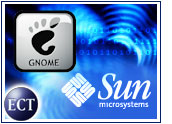
The latest update to Sun Microsystems’ Solaris operating system includes the option of using the open-source Gnome desktop interface, but the network computing giant is still sending mixed signals on open source and Linux, according to industry analysts.
The release, called Solaris 9 8/03, is scheduled for August 13th and will include support for Sparc- and x86-based systems, Sun said. The default user interface still will be Sun’s Common Desktop Environment (CDE), though users will have the option of using the Sun-supported open-source interface known as Gnome 2.0.
Forrester industry analyst Stacey Quandt told TechNewsWorld that although integration of Gnome likely will broaden support for Solaris, Sun is still failing to embrace the open-source community completely. “[The Solaris update] is a step in the right direction to keep the Solaris installed base; it’s not the right step if they want to be taken seriously as a Linux provider,” Quandt said.
New Gnome Integration
Although CDE will still be the default user interface for Solaris 9 8/03, users will have the choice to log on with the Gnome interface and then set it as the default.
The latest update to Solaris, which also includes a Unix file system and improvements to the system’s live-upgrade feature, represents the first inclusion of an open-source interface for the OS.
By adding Gnome support to Solaris, Quandt said, Sun is using a technology that has wide industry support and thus will be able to supply its operating system to a broader, deeper community.
Changing Ways
Yankee Group senior analyst Dana Gardner said he views the move as an olive branch to the open-source community, which in the past has experienced Sun’s “provincial stance” on interfaces.
“They’ve taken overdue steps to become a real partner to Linux and open source instead of providing lip service first,” Gardner told TechNewsWorld. “With their strategy, they’re recognizing that the Linux movement is not a flash in the pan.”
He added that integration of Gnome into Solaris represents a larger dedication to Linux and open source, which Sun previously has avoided in favor of a more tentative, “appropriated stack” approach.
Solaris Support Stings
Forrester’s Quandt said that while Sun has Linux solutions in its portfolio, the company still is not perceived as a true backer of Linux and open source.
“From a software perspective, Sun’s credibility as a Linux provider consists of its preference for supplying Solaris,” she told TechNewsWorld. “They continue to market around the value of Solaris and are refusing to see a significant number of customers want a Linux solution.”
Quandt noted that by not offering a Linux-based alternative to Solaris, Sun has segmented the market in a way that gives its competitors significant business.
“There are still several Solaris shops that continue to evaluate staying the course versus migration to Linux on x86,” she said. “It remains to be seen how significant these updates are, given the focus on reducing IT spending.”
Solaris Stays Tough
However, Yankee’s Gardner said the Solaris operating environment “remains on the bleeding edge in a lot of technical areas” and — like the open source movement — is not going away anytime soon.
Gardner added that improved throughput capacity, scalability and support for clustering and other IT consolidation efforts likely will position Solaris well in the market going forward.
“Also, Solaris has maintained a strong brand around its ability to be safe against tampering and invasion,” he said. “It has stood the test of time. Whereas Linux support is building up, there’s still some hesitation around security and liability with it.”





















































